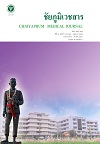การทบทวนวรรณกรรมและวิเคราะห์อภิมานเพื่อประเมินผลการผ่าตัดลดขนาดเยื่อบุกระดูกเทอร์บิเนตโต ด้วยคลื่นความถี่วิทยุ เทียบกับ การใช้เครื่องปั่นดูด
คำสำคัญ:
turbinoplasty, turbinate reductionบทคัดย่อ
การทบทวนวรรณกรรมอย่างเป็นระบบ (Systematic Review) และการวิเคราะห์อภิมาน (Meta-Analysis) เพื่อประเมินผลการผ่าตัดลดขนาดเยื่อบุกระดูกเทอร์บิเนตส่วนล่างโต ด้วยคลื่นความถี่วิทยุ (inferior turbinate reduction with radiofrequency, IFTR) เทียบกับ การใช้เครื่องปั่นดูด (microdebrider-assisted turbinoplasty, MAT) ค้นหาจากฐานข้อมูล MEDLINE, EMBASE, PUBMED, SCOPUS และ COCHRANE
ผลการศึกษา : จากผลการศึกษาทั้งหมด 25 เรื่อง (ผู้ป่วย 679 ราย) กลุ่ม microdebrider (MAT) มีอาการคัดจมูกลดลงภายหลังผ่าตัด (VAS) อย่างชัดเจน แต่ยังไม่มีนัยสำคัญทางสถิติ [ช่วงความเชื่อมั่น 95% (CI) (-1.63, 4.33); P = 0.24] โดยมีค่าเฉลี่ยของคะแนน VAS ดีขึ้นประมาณ 1.63 คะแนน แต่การตรวจ Total nasal resistance (TNR) ด้วย acoustic rhinomanometry ไม่พบความแตกต่างที่มีนัยสำคัญทางสถิติ [ช่วงความเชื่อมั่น 95% (CI) (-0.02, 0.02); P = 0.81] กลุ่มที่ใช้คลื่นความถี่วิทยุ มีอาการน้ำมูกไหลภายหลังผ่าตัด มากกว่าเล็กน้อย อย่างมีนัยสำคัญทางสถิติ [ช่วงความเชื่อมั่น 95% (CI) (0.02, 0.11); P = 0.004] โดยมีค่าเฉลี่ยของคะแนนต่างกันประมาณ 0.07 คะแนน กลุ่ม microdebrider (MAT) มีภาวะเลือดออกภายหลังผ่าตัด มากกว่าอย่างมาก และแตกต่างกันอย่างมีนัยสำคัญทางสถิติ [ช่วงความเชื่อมั่น 95% (CI) (0.08, 0.44); P = 0.0001] โดยมีอัตราเสี่ยงเลือดออกหลังผ่าตัด ประมาณ 1ต่อ 0.18 เท่า (หรือ 5.6 ต่อ 1 เท่า) เมื่อเทียบกับ กลุ่มที่ใช้คลื่นความถี่วิทยุ
สรุป : การผ่าตัดด้วย MAT ลดอาการคัดจมูกมากกว่า แต่ทำให้เกิดความเสี่ยงต่อภาวะเลือดออกภายหลังการผ่าตัดมากกว่า การผ่าตัดด้วยคลื่นความถี่วิทยุ (IFTR) อย่างชัดเจน
เอกสารอ้างอิง
Huang TW, Cheng PW. (2006). Changes in nasal resistance and quality of life after endoscopic microdebrider-assisted inferior turbinoplasty in patients with perennial allergic rhinitis. Archives of otolaryngology--head & neck surgery, 132(9):990-3.
Swift AC, Campbell IT, McKown TM. (1988). Oronasal obstruction, lung volumes, and arterial oxygenation. Lancet (London, England, 1(8577):73-5.
Hol MK, Huizing EH. (2000). Treatment of inferior turbinate pathology: a review and critical evaluation of the different techniques. Rhinology, 38(4):157-66.
Lee HM, Park SA, Chung SW, Woo JS, Chae SW, Lee SH, et al. (2006). Interleukin-18/-607 gene polymorphism in allergic rhinitis. International journal of pediatric otorhinolaryngology, 70(6):1085-8.
Hoover S. (1987). The nasal patho-physiology of headaches and migraines. Diagnosis and treatment of the allergy, infection and nasal septal spurs that cause them. Rhinology Supplement, 2:1-23.
Bhandarkar ND, Smith TL. (2010). Outcomes of surgery for inferior turbinate hypertrophy. Current opinion in otolaryngology & head and neck surgery, 18(1):49-53.
Koleli H, Paltura C, Sahin-Yilmaz A, Topak M, Develioglu ON, Kulekci M. (2014). Peak nasal inspiratory flowmetry for selection of patients for radiofrequency ablation of turbinates. The Annals of otology, rhinology, and laryngology, 123(7):457-60.
Back LJ, Hytonen ML, Malmberg HO, Ylikoski JS. (2002). Submucosal bipolar radiofrequency thermal ablation of inferior turbinates: a long-term follow-up with subjective and objective assessment. The Laryngoscope, 112(10):1806-12.
Fanous N. (1986). Anterior turbinectomy. A new surgical approach to turbinate hypertrophy: a review of 220 cases. Archives of otolaryngology--head & neck surgery, 112(8):850-2.
Martinez SA, Nissen AJ, Stock CR, Tesmer T. (1983). Nasal turbinate resection for relief of nasal obstruction. The Laryngoscope, 93(7):871-5.
Gupta A, Mercurio E, Bielamowicz S. (2001). Endoscopic inferior turbinate reduction: an outcomes analysis. The Laryngoscope, 111(11 Pt 1):1957-9.
Van delden MR, Cook PR, Davis WE. (1999). Endoscopic partial inferior turbinoplasty. Otolaryngology--head and neck surgery : official journal of American Academy of Otolaryngology-Head and Neck Surgery, 121(4):406-9.
Liberati A, Altman DG, Tetzlaff J, Mulrow C, Gotzsche PC, Ioannidis JP, et al. (2009). The PRISMA statement for reporting systematic reviews and meta-analyses of studies that evaluate health care interventions: explanation and elaboration. Annals of internal medicine, 151(4):W65-94.
Fatih A, Mehmet I, Hatice B, Ahmet U. (2016). Comparison of radiofrequency thermal ablation and microdebrider-assisted turbinoplasty in inferior turbinate hypertrophy: a prospective randomized and clinical study. Turk Arch Otorhinolaryngol, 54: 118-23.
Cingi C, Ure B, Cakli H, Ozudogru E. (2010). Microdebrider-assisted versus radiofrequency-assisted inferior turbinoplasty: a prospective study with objective and subjective outcome measures. Acta Otorhinolaryngol Ital, 30:138–43.
Teemu H, Jura N, Ilkka K, Markus R. (2018). A prospective randomized placebo-controlled study of inferior turbinate surgery. Laryngoscope, 128(9):1997-2003.
Lee JY, Lee JD. (2006). Comparative study on the long-term effectiveness between coblator and microdebrider-assisted partial turbinoplasty.Laryngoscope, 116:729-34.
. Liu CM, Tan CD, Lee FP, Lin KN, Huang HM. (2009). Microdebrider-assisted versu radiofrequency-assisted inferior turbinoplasty. Laryngoscope, 119:414–8.
Hassan MH, Mohamed RE, Abobakr B. (2014). Inferior turbinate reduction: coblation versus microdebrider - a prospective, randomised study. Rhinology, 52:306-14.
ดาวน์โหลด
เผยแพร่แล้ว
ฉบับ
บท
การอนุญาต
ลิขสิทธิ์ (c) 2021 ชัยภูมิเวชสาร

This work is licensed under a Creative Commons Attribution-NonCommercial-NoDerivatives 4.0 International License.





